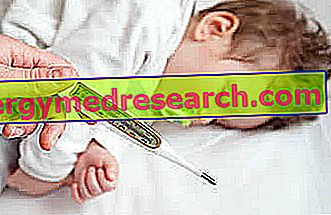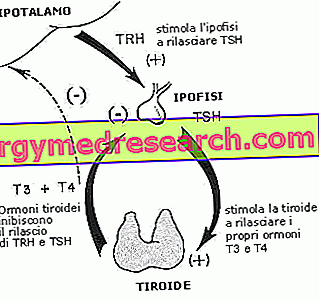Fever: When to worry?
Fever in children is the most common reason for requesting a visit from the family, especially because it causes concern in the family group.

There is a very simple tool for identifying the probability of facing a serious pathology in the case of a febrile child, and it is based on the use of the three colors of the traffic light: green, yellow and red.
Children with fever and with exclusive signs and / or symptoms of the green column are at low risk; children with one or more symptoms of the yellow column are at intermediate risk and babies with one or more symptoms of the red column are at high risk.
FEVER IN THE CHILD - GREEN TRAFFIC LIGHT | |
| Color | Normal color of skin, tongue and lips |
| Reactivity | The child carries out his normal activities, he is happy / smiling, he is awake and / or easily awakened, he does not cry and when he does the crying is normal |
| Hydration | The skin and eyes are normal and the mucous membranes are moist |
| Other | No sign or symptom of yellow or red |
FEVER IN THE CHILD - THE YELLOW TRAFFIC LIGHT | |
| Color | Pallor |
| Reactivity Breath | It appears listless, mogio; awakens but with difficulty or if stimulated for a long time; does not smile. Widening of nasal fins; tachypnea (increased respiratory rate> 50 acts per minute between 6 and 12 months;> 40 / min over 12 months); sialorrhea (loss of saliva from the mouth). |
| Hydration | Dry mucous; unsatisfactory nutritional status; oliguria (very little urine during the day); capillary filling time * ≥2 seconds. |
| Other | Fever for more than 5 days; joint or limb swelling; lameness; adenopathy (presence of painful masses, especially on the sides of the neck, or of any mass greater than 2 cm). |
FEVER IN THE CHILD - THE RED TRAFFIC LIGHT | |
| Colorful | Pale / marbled / gray / bluish |
| Reactivity | Responds little to stimuli; can't wake up or go back to sleep immediately; faint cry, high-pitched, continuous. |
| Breath | Presence of groan in inspiration; increase in respiratory rate above 60 acts per minute; thoracic recesses. |
| Hydration | Reduced skin turgor |
| Other | Age 0-3 months: temperature ≥ 38 ° C Age 3-6 months: temperature ≥ 39 ° C Neck stiffness; neurological signs; convulsions; bilious vomiting (green). |
What to do?
The first thing to do when you are in front of a child with a fever is to assess whether there is a life-threatening condition due to compromised airways (A = Airways), breath (B = breathe), and the circle (C = Circle) and state of consciousness.
We will then go on to look for the presence of signs and symptoms of gravity (the traffic light), then again to find the cause of the fever and specific signs and symptoms. The heart rate (pulse) and respiratory rate, the capillary filling time must be measured (crushing the nail surface for a few seconds and seeing how quickly they recolor after leaving the grip), and the state of hydration is evaluated.
Causes of fever in the child
The causes of fever in the child can be the most varied. The main diseases that can cause it, associated with the main signs and symptoms, are:
| Influenza syndrome | Sore throat, cough and airway congestion, conjunctivitis, muscle pain, loss of appetite, prostration. |
| Exanthematic diseases or other non-exanthematous infectious diseases related to childhood | Skin rashes (macules, papules or vesicles), associated or not with sore throat, cough and airway congestion, muscle pain, loss of appetite, prostration. |
| Meningitis da Meningococcal ( Neisseria Meningitidis ) | Erythema of the skin, located mainly at the extremities, which does not disappear under pressure with the finger and is characterized by reddish lesions with a diameter greater than 2 millimeters; suffering child; capillary filling time ≥2 seconds; stiffness of the neck; impairment of the state of consciousness; convulsions; headache; nausea; vomiting not related to meal intake |
| Encephalitis | Focal neurological signs (affecting only a sphere of behavior or movement); impairment of the state of consciousness; convulsions |
| Pneumonia | tachypnea; chest recesses; cyanosis (bluish color of the skin); enlargement of the nasal fins |
| Street infections urinary | He retched; loss of appetite; lethargy; irritability; abdominal pain; dysuria (pain and / or burning to urinate); hematuria (presence of blood in the urine) |
Septic arthritis and / or osteomyelitis | Joint swelling; ache; lameness |
| Kawasaki (autoimmune disease that affects the arteries) | Fever lasting more than 5 days plus four of the following signs:
|
Summing up, behaving in the following way in front of a child with a fever:
- if the symptoms present indicate a potential danger to life, it is immediately sent to the emergency room. If this does not happen, the severity of the signs and symptoms must be assessed according to the "traffic light" rules:
- with green symptoms the child can be treated at home, with yellow symptoms or in the absence of a diagnosis, he must be sent to the pediatrician and, with at least one red symptom, he must be urgently sent to the pediatrician (within 2 hours).
Child fever medications »



